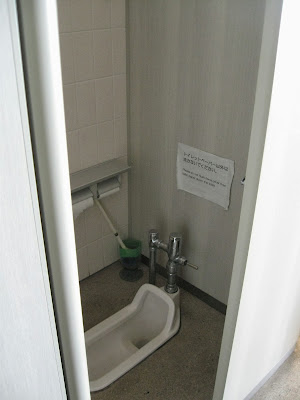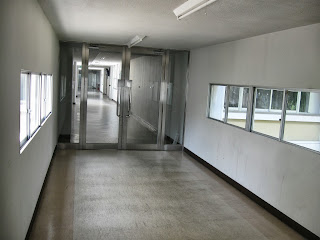School structure
This topic may be of interest to students coming to Nara in the same or similar situation as I.
The American students (usually a small handfull from CMU and Lockhaven in Pennsylvania) come at the end of August. Then our classes start the first week of September.
However everyone else including the Japanese students doesn't start until October.
So it does give us time to get adjusted and improve our language skills since the (mainly) eastern European and other international students will come at the end of September, and their skills are typically more advanced than ours.
Our classes at first were separated between the CMU and Lockhaven students since the CMU students had taken between a year or two of Japanese language classes, and Lockhaven doesn't have Japanese classes.
The Americans have one class where we are all together which is taught in English and it is on Japanese history and is really interesting and detailed.
When the classes start in October the CMU students will have the first class with the more advanced international students, but after that our professor will decide if it is too difficult for us and then if we need to have a separate class.
I am sort of worried, but at the same time 'it is what it is' and I will try my best and be put where I need to be- like the Japanese sorting hat I suppose.
Either way I will keep trying my best to improve and enjoy my short stay (compared to the 99% who stay a year or more) in Nara.
I am really happy to have the option of going for a semester, though, since it really fits well with my plans quite perfectly.
Tomorrow is our ceremony where we are welcomed and we basically bow and nod for an hour and listen to the school's top leaders talk to us about the school.
Typically the welcome or initiation ceremonies are held in April for Universities and large companies but we are arriving in September and October so ours is done later.
Eating Habits
Like anywhere, eating habits are what you make them. Sometimes it is actually easier to eat healthy foods here in Nara, since there are many traditional foods to choose from.
Often I eat mushrooms with miso udon soup that I make myself because it is so easy, cheap and healthy. Sometimes I eat Onigiri rice balls with tuna in the middle.
However it is also easy to eat unhealthy and expensive if you want to. For example I know people that eat fried foods, sweet foods, and artificial foods often.
It is a little difficult to eat the same foods as I do in America such as whole wheat or pumpernickel breads, I haven't seen or eaten cereal in ages, and milk is good but not as amazing as the farm fresh kind I like.
You can easily find many types of vegetables especially at the stores, or you can get the sweets and fried foods at the konbini's too if you like.
It's really up to you, but for me it has been easier than in America to eat healthily in that I can easily find a variety of mushrooms especially. However since I can hardly read the vast amount of Kanji writing on the labels, I often cannot read the ingredients listings like I usually like to do.
So if you think its expensive to feed yourself here, it really depends on your choices, just like in your home country.
If you want fruits, (like apples) many of them are going to be more expensive than in say Michigan.
But the mushrooms are cheap and great! So it's a trade off on different items and if you change your eating habits to fit in like the locals you should be able to save some money.
If you plan to eat like an American, you may have to pay more depending on what you typically eat.
Personally I wish I could eat the deer that roam everywhere here, but it's not going to happen.
This topic may be of interest to students coming to Nara in the same or similar situation as I.
 |
| School restroom sinks remind me of Hogwarts a little. |
The American students (usually a small handfull from CMU and Lockhaven in Pennsylvania) come at the end of August. Then our classes start the first week of September.
 |
| I highly recommend looking in the school library. |
However everyone else including the Japanese students doesn't start until October.
 |
| Nara Uni library has many interesting books that are in English. |
So it does give us time to get adjusted and improve our language skills since the (mainly) eastern European and other international students will come at the end of September, and their skills are typically more advanced than ours.
Our classes at first were separated between the CMU and Lockhaven students since the CMU students had taken between a year or two of Japanese language classes, and Lockhaven doesn't have Japanese classes.
 |
| Sometimes you have to use the Washiki traditional Japanese toilets |
The Americans have one class where we are all together which is taught in English and it is on Japanese history and is really interesting and detailed.
 |
| They usually also have a Western style toilet too. |
When the classes start in October the CMU students will have the first class with the more advanced international students, but after that our professor will decide if it is too difficult for us and then if we need to have a separate class.
I am sort of worried, but at the same time 'it is what it is' and I will try my best and be put where I need to be- like the Japanese sorting hat I suppose.
 |
| A view from the hallway at Nara University of Education. |
Either way I will keep trying my best to improve and enjoy my short stay (compared to the 99% who stay a year or more) in Nara.
I am really happy to have the option of going for a semester, though, since it really fits well with my plans quite perfectly.
Tomorrow is our ceremony where we are welcomed and we basically bow and nod for an hour and listen to the school's top leaders talk to us about the school.
 |
| A Hallway near my classes at NUE. |
Typically the welcome or initiation ceremonies are held in April for Universities and large companies but we are arriving in September and October so ours is done later.
Eating Habits
Like anywhere, eating habits are what you make them. Sometimes it is actually easier to eat healthy foods here in Nara, since there are many traditional foods to choose from.
Often I eat mushrooms with miso udon soup that I make myself because it is so easy, cheap and healthy. Sometimes I eat Onigiri rice balls with tuna in the middle.
However it is also easy to eat unhealthy and expensive if you want to. For example I know people that eat fried foods, sweet foods, and artificial foods often.
It is a little difficult to eat the same foods as I do in America such as whole wheat or pumpernickel breads, I haven't seen or eaten cereal in ages, and milk is good but not as amazing as the farm fresh kind I like.
You can easily find many types of vegetables especially at the stores, or you can get the sweets and fried foods at the konbini's too if you like.
 |
| Traditional foods like soup and rice often accompany even non-traditional foods. Dining out, foods are often pretty filling. |
It's really up to you, but for me it has been easier than in America to eat healthily in that I can easily find a variety of mushrooms especially. However since I can hardly read the vast amount of Kanji writing on the labels, I often cannot read the ingredients listings like I usually like to do.
So if you think its expensive to feed yourself here, it really depends on your choices, just like in your home country.
If you want fruits, (like apples) many of them are going to be more expensive than in say Michigan.
But the mushrooms are cheap and great! So it's a trade off on different items and if you change your eating habits to fit in like the locals you should be able to save some money.
If you plan to eat like an American, you may have to pay more depending on what you typically eat.
Personally I wish I could eat the deer that roam everywhere here, but it's not going to happen.
 |
| The view outside my balcony. |

















































